#The Travels of Sir John Mandeville
Text
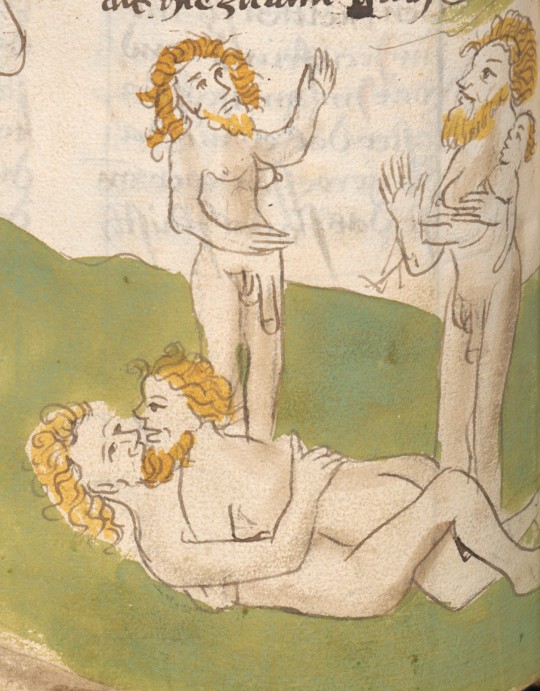


queer sex and more!
in an illustrated medieval travelogue (a german translation of "mandeville's travels"), bavaria/swabia, ca. 1476
source: Vienna, ÖNB, Cod. 2838, fol. 102v
#i feel like this hasn't really been posted on the internet before?? 👀#and none of the existing catalogue descriptions mention the queer imagery at all (disappointed but not surprised)#nor does any of the secondary literature on the manuscript!! (judging by the titles)#you need to understand my approach for this blog is just to browse through hundreds of pages of random digitized manuscripts#ummm anyways#15th century#medieval art#illuminated manuscript#blemmyes#queer#gender stuff#otto von diemeringen#mandeville's travels#jean de mandeville#The Travels of Sir John Mandeville#nudity#medieval studies#gender
1K notes
·
View notes
Text
Excerpt from Chapter 1 of Eric Quayle's Early Children's Books: A Collector's Guide (1983)
FROM WILL SHAKESPEARE TO WILL WYCHERLEY, pp. 12-14
"The percentage of children who could read or look at picture books in the Middle Ages was minutely small, and even these favoured few could seldom have been allowed to handle personally the illuminated manuscripts which depicted, often in graphic and exciting form, the myths and legends of earlier days in religious history. One can imagine a kindly monk lifting up a wondering boy as he turned the vellum leaves and told the story they unfolded . . . A fanciful picture of a scene more likely to have been enacted between a pedagogue and his pupil in the latter half of the fifteenth century, the boy being taught his alphabet and figures by repeating the letters from his horn-book.
"Reading for pleasure was practically unknown for the young of those days, and, not surprisingly, few, if any, juvenile manuscripts that may have passed from hand to hand have survived. After the invention of printing with movable metal type about 1456, and the setting up of William Caxton's press at Westminster about twenty years later, there was still to be a long wait before any work remotely interesting to children made its appearance. Then, on 26 March 1484, 'in the first year of the reign of King Richard the Third,' Caxton finished his translation from the French of Aesop's Fables. The book of the subtyl hystoryes and Fables of Esope, with its woodcut illustrations, was not in any way intended by Caxton as a text for the young, but, since this first translation into English nearly five hundred years ago, the work in various forms and illustrated by scores of artists has remained in print almost exclusively for a juvenile audience.
"One of the most popular collection of of tales of the Middle Ages was Gesta Romanorum, compiled in Latin, almost certainly in England, around 1300, which appeared in manuscript in English during the fifteenth century. The Acts of the Romans, as it was usually called, is believed to have been written in order to supply a series of entertaining stories for regaling the brothers of an unidentified abbey and was probably compiled by one of their number to lighten the long nights of winter. The earliest manuscript versions differ widely in the tales they tell, but all are romances of chivalry and legends of saintly deeds, and to each of the stories a moral is attached. They supplied material for many subsequent authors, and in modified form provided the sort of adventure story reading beloved of children. Long before the invention of printing the youth of the fourteenth and fifteenth centuries must have thrilled to the accounts of Roman heroes dressed as they were in the garb of early medieval knights, slaying Greeks and dragons with equal impunity. Caxton's successor, Wynkyn de Worde, who had joined the master in London in 1477, and who inherited Caxton's press on his death in 1491, was the first to print Gesta Romanorum. Versions of his text, in abbreviated form and illustrated with crude little woodcuts, were read by children for their own amusement throughout the next four centuries, many carrying little homilies on their title-pages, such as:
"The Story's pleasant, and the moral good,
If read with Care, and rightly understood.
"Another favourite with children must have been the various Bestiaries, described by M. R. James in his treatise on the subject, The Bestiary, 1928, as 'one of the leading picture-books of the twelfth and thirteenth centuries in this country.' These were early natural history, with many of the animals depicted being fabulous, but none the less fearsome for that. The Voiage and Travaile of Sir John Maundevile, Kt, a purely fictitious work written originally in French, purported to be a guide to pilgrims to the Holy Land, and must have proved extremely entertaining to youth from the middle of the fourteenth century onwards with its tales of ant-hills of gold dust; tribes of one-footed men 'and the foot so large that it shadeth all the Body against the Sonne when they lye down and raze it'; of wells whose water changes colour at the stroke of every hour; trees which bear honey and whose sap is wine; a one-eyed tribe, with the orb in the centre of their foreheads; and much more in the same vein with pictures to prove the statements true.
"None of these works was in any way intended for children, either in manuscript or in later book form, and we have to wait until the final quarter of the sixteenth century, to a time when William Shakespeare was a boy of sixteen, before the first purpose-made picture book for children made its appearance.
"Kunst und Lehrbüchlein was first published in Germany in 1578, but this issue was merely a hotch-potch of illustrations culled from a variety of works which the publisher, Sigmund Feyerabend (1528-1590), had commissioned during the previous decade. Book of Art and Instruction for Young People, to give the work its English title, was re-issued in 1580 as a book specially prepared for the youth of the day."
#Wynkyn de Worde#children's books#books#history of books#book collecting#middle ages#medieval#legends#romances#woodcuts#illustrations#William Caxton#picture books#The Travels of Sir John Mandeville#the bestiary#bestiaries#m. r. james#aesop's fables
1 note
·
View note
Note
“You can’t be a Muslim because you drink alcohol and eat pork” is a deeply modernist, voyeuristic understanding of Islam. I was just reading The Travels of Sir John Mandeville and he literally mentions that the Saracens secretly drink wine even tho they’re not supposed to and this shit was literally written in the 1300s
In Adeeb Khalid’s ‘Islam After Communism,’ he finds himself in a factory canteen in Uzbekistan interviewing Muslim workers, and when they find out he’s a Muslim too a bottle of vodka appears from nowhere and they all have a drink to celebrate
176 notes
·
View notes
Text

I want to adopt this very silly interpretation of a cotton plant from The Travels of Sir John Mandeville as my personal badge
2 notes
·
View notes
Text

@ave-immaculata, I'm actually unsure of where I first originally heard of either tradition!
But the fourteenth century travelogue The Travels of Sir John Mandeville reference the 72-as-age-of-death tradition, taking for granted that the reader would already be aware of this fact. The Franciscan Crown, a chaplet focused on meditating on the seven joys of Mary, involves 72 Hail Marys total, with the justification being each one is representative of a year of her life (this devotion started in the fifteenth century).
Also from the fifteenth century, there is a preserved commonplace book from Norfolk in East Anglia which states that Mary was 63 when she died; the 20th century Catholic mystic Catherine Emmerich agrees with this, saying that Mary was just three weeks short of her 64th birthday when she passsed. The Brigittine Rosary, which is connected to the fourteenth century Saint Bridget of Sweden, connects its use of 63 Hail Marys to the number of years the Virgin Mary is supposed to have lived.
6 notes
·
View notes
Text
books i might wanna read when i don’t have 67123576512 other things to read or whatever if you’re curious you can just google the titles because i didn’t save all the info in my notes app
Voices from the Chinese Century: Public Intellectual Debate from Contemporary China
The Crooning Wind: Three Greenlandic Poets
Untrodden Peaks and Unfrequented Valleys
Crude Chronicles: Indigenous Politics, Multinational Oil, and Neoliberalism in Ecuador
In the Shadow of Islam
The Black Jacobins: Toussaint L'Ouverture and the San Domingo Revolution
Seeing Like a State
White Skin, Black Fuel: On the Danger of Fossil Fascism
Memory and the Mediterranean
Losing Earth: A Recent History
Cosmic Liturgy: The Universe According to Maximus the Confessor
Karlamagnús Saga: The Saga of Charlemagne and his Heroes
The Sinner and the Saint: Dostoevsky and the Gentleman Murderer Who Inspired a Masterpiece
Icebound: Shipwrecked at the Edge of the World
Panpsychism in the West
Facing the Anthropocene: Fossil Capitalism and the Crisis of the Earth System
Marx's Ecology: Materialism and Nature
The Savage Frontier: The Pyrenees in History and the Imagination
Winter Pasture: One Woman's Journey with China's Kazakh Herders
Babur Nama: Journal of the Emperor Babur
The Singer of Tales by Albert Bates Lord
Slavery and Empire in Central Asia
The Adventures of Sayf Ben Dhi Yazan: An Arab Folk Epic
The Travels of Ibn Battutah
I Burn Paris by Bruno Jasieński
The Book of Dede Korkut
The knight in the Panter’s SkinTravels with Herodotus by Ryszard Kapuściński
Deep Sea and Foreign Going
Big Dead Place: Inside the Strange and Menacing World of Antarctica
The Story of the Mongols Whom We Call the Tartars
The Journey Of William Of Rubruck To The Eastern Parts Of The World
Recollections of Tartar Steppes and Their Inhabitants
The Expedition of Cyrus by Xenophon
Xenophon's Retreat: Greece, Persia, and the End of the Golden Age
From Samarkhand to Sardis: A New Approach to the Seleucid Empire
The Gobi Desert - The Adventures of Three Women Travelling Across the Gobi Desert in the 1920s
Black Lamb and Grey Falcon
Forbidden Journey by Ella Maillart
The Riddle of the Labyrinth: The Quest to Crack an Ancient Code
The Many Worlds of Hugh Everett III: Multiple Universes, Mutual Assured Destruction, and the Meltdown of a Nuclear Family
Cycles of Time: An Extraordinary New View of the Universe
The Poorer Nations: A Possible History of the Global South
No Less Than Mystic: A History of Lenin and the Russian Revolution for a 21st-Century Left
Philosophy and Real Politics
Writing East: The "Travels" of Sir John Mandeville
Poetry of the Taliban
Cabool by Alexander Burnes
Warrior Saints of the Silk Road |
The Place of the Skull by Chingiz Aitmatov
Starship & the Canoe
Nauru Burning
Our Women on the Ground: Essays by Arab Women Reporting from the Arab World
Death Is Hard Work
The Rights of Nature: A History of Environmental Ethics
A Grain of Wheat
Fossil Capital: The Rise of Steam Power and the Roots of Global Warming
Annals of the Former World
So Long a Letter by Mariama Bâ
The Jakarta Method: Washington's Anticommunist Crusade and the Mass Murder Program that Shaped Our World
3 notes
·
View notes
Text
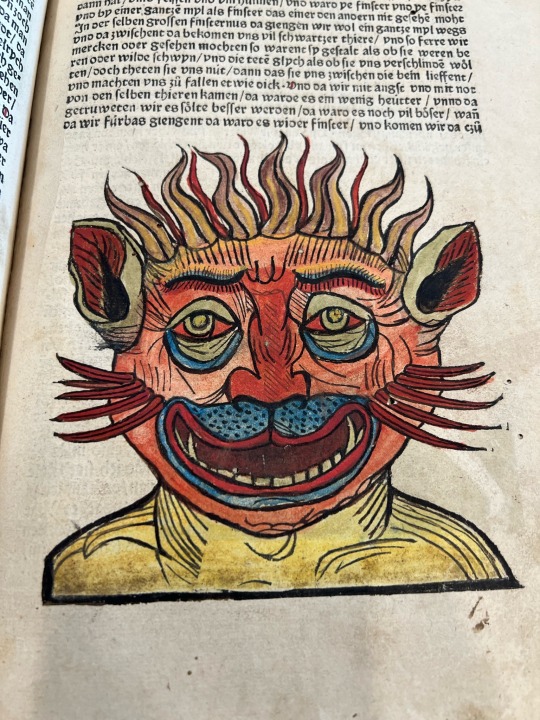
Lion man of the Far East, from the Travels of Sir John Mandeville, translated into German by Otto von Diemeringen. Woodblock print with hand painted colors. This edition is from 1484, although the original text is from the 14th century.
1 note
·
View note
Text
The Dragon of Cos in Mandeville
This is your Monster of the Month.
This week we revisit Sir John Mandeville, an entirely fictitious author, whose travel journals in the 14th century gave the Christians great hope that there was a great Christian Emperor in India who was going to rescue the Holy Land.
Mandeville talks about how he goes to Prester John’s Court, and on the way there he stops on the island of Cos, where there are…

View On WordPress
0 notes
Note
Is there any way we can be even better friends to you?
hmm... well, one of my favorite things ever is worldbuilding, I have many worldbuilding projects on various google docs. I'm a big fan of weird yet internally logical worlds with fucked-up-yet-clearly-natural creatures (that's why I made Blackpowder Engine actually), speaking of that, if you can draw I'd love little more than art of it's characters, even just commissioning someone else to do it would be fantastic. so those are things. I like history too, especially how different cultures interacted and what people thought lived on the edges of the maps, I'm a big fan of, for instance, the roman delegation to china, the Greco-Bactrian empire in Afghanistan, the travels of Marco Polo and Sir John Mandeville, that kinda stuff. big fan of caves.
0 notes
Text

“In one of these isles be folk of great stature, as giants. And they be hideous for to look upon. And they have but one eye, and that is in the middle of the front. And they eat nothing but raw flesh and raw fish. And in another isle toward the south dwell folk of foul stature and of cursed kind that have no heads. And their eyen be in their shoulders.”
The Voyages and Travels of Sir John Mandeville, 1582

OTHELLO:
[…] It was my hint to speak,--such was the process;
And of the Cannibals that each other eat,
The Anthropophagi and men whose heads
Do grow beneath their shoulders. This to hear
Would Desdemona seriously incline:

#othello#shakespeare#these guys#i like em#this is basically me recreating the footnote#in the folger edition of Othello that got me into em
1 note
·
View note
Text

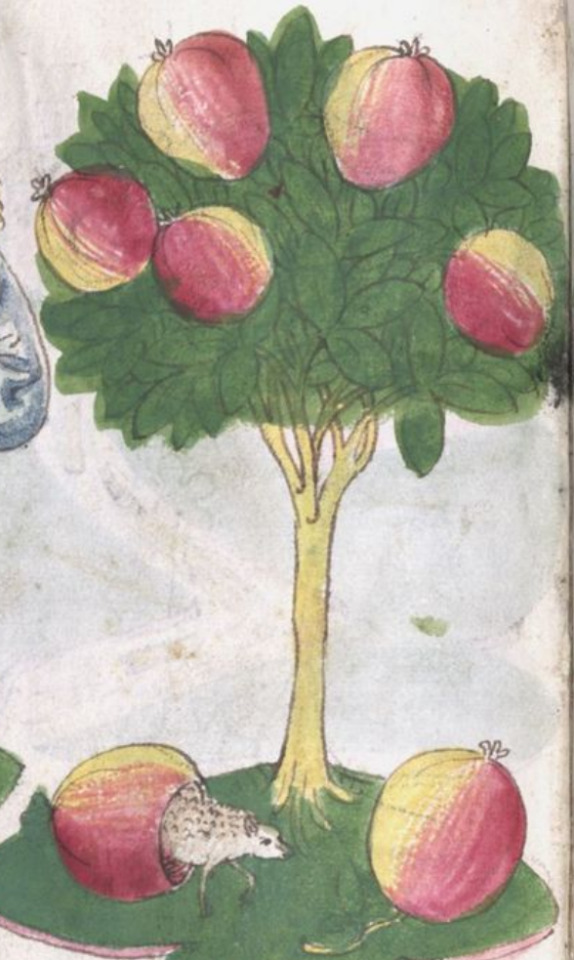


animals hatching from fruits
in a german translation of "mandeville's travels", ca. 1470
source: Stuttgart, Landesbibliothek, Cod. theol. et phil. 2° 195, fol. 176v and 175r
#not the same manuscript that contains the gay sex illustration in case you were wondering#also sorry for the bad resolution it's not my fault#15th century#mandeville's travels#the travels of sir john mandeville#hatching#medieval art#medieval illustrations#medieval manuscript
290 notes
·
View notes
Photo

Wild and and non-binary-sexed figures, Jean de Mandeville, Antichrist (Travels of Sir John Mandeville), St.Gallen, Stiftsarchiv, Cod.Fab.XVI, f.66v. Photo: www.e-codices.ch
0 notes
Text
Winnie the Pooh-John Mandeville style
I’ve been researching 17th century typography, typesetting, spelling, and grammar. And the one thing I take away from this, there weren’t any rules about spelling.
So one of the books I’ve been staring at is the English Hous-wife. A book telling women everything they need to know to run a proper house.
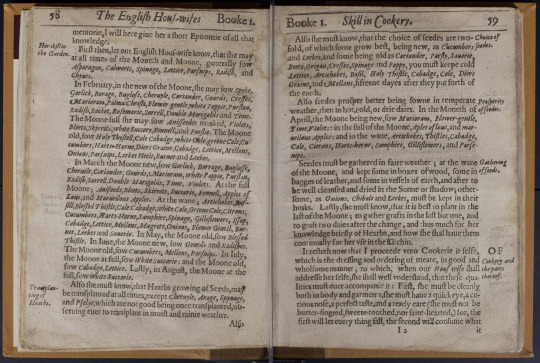
I like the layout and decided that adding a few woodcut-style images would make for a nice book spread. The annotations in the margins were inserted by the typesetter. They weren’t handwritten. More like place markers when you’re leafing through looking for something.
Next I had to decide on the woodcut style. After browsing my collection, I decided on a more simplistic style.
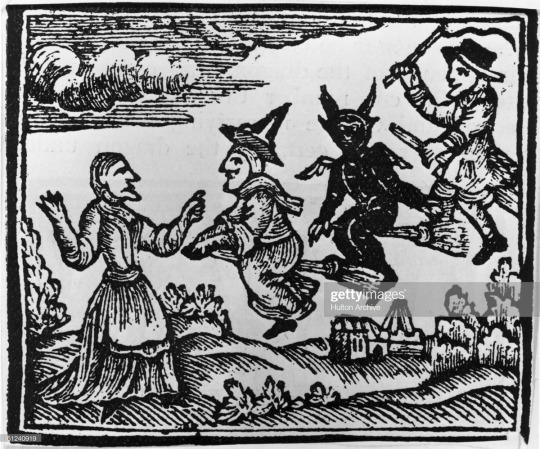


They may get more complex in upcoming projects but this style would do well for the first one.
Finally, they subject. I believe it came from viewing two things in quick succession in a rash of searches. First was some vintage maps and second the Shepard illustrations from Winnie the Pooh. It was then I decided this would become a two-fold project: A book spread with an accompanying map.
The map would be the easier of the two so that went first. I’ve dealt with maps for ages so this went quickly. The only addition I made was making it appear as if the map was folded up.

Next was the text I needed for the book spread. So I read a few chapters from The Travels of Sir John Mandeville to get the metre I needed. So I wrote enough text to will my two pages. The font was easy as I have an appropriate 17th century book font. It was the grammar and spelling I needed to work on. At first I was doing all the adjustments manually. That was until I found a web page to translate modern English into Shakespearean English. It had a few oddities but the base text was enough for my purposes. I added a few other respellings and grammar I liked. Tossed in a few annotations. Made it look similar to The English Hous-Wife and got this which I placed on a blank set of pages in a historical manuscript. The little bookholders on the left and right help it to appear as a real book on display.

I like the end results and plan on creating more typeset books in this fashion
#medievil manuscript#17th century#typesetting#woodcut#winnie the pooh#tigger#the travels of sir john mandeville
1 note
·
View note
Photo

this was funnier in my head
#is this a pigeon?#medieval literature memes#memes#medieval literature#the travels of sir john mandeville#fun facts: many medieval authors called any and all fruits apples#we literally have no idea why#they ... just did???#this was by far the funniest example that i read last year#like he very obviously describes a banana and yet#mine#tbh this text is chock full of interesting and funny stuff#there is also references to places that we have no idea where they are#their location was probably common knowledge in the text's time but now#we just dont fucking know#also some plants that we have no fucking clue what they are#i love this text#tbh i forgot about it until last night at girl's night we were sharing fruit facts#and this came up and into my head#lit blogging
6 notes
·
View notes
Photo

"How's the reading for your medieval lit class going?"
25 notes
·
View notes
Text
obsessed with this illustration from The Voyage and Travels of Sir John Mandeville (published between 1357-1371), they look like theyre having a fun gossip session at the beach

[Image Description: a drawing of four beings, each gesturing to each other. from left to right they are a man lying on his back with his singular leg in the air, ending in a large foot; a cyclops; a man with no head and his face on his chest; a man with a dog's head. end ID]
9 notes
·
View notes